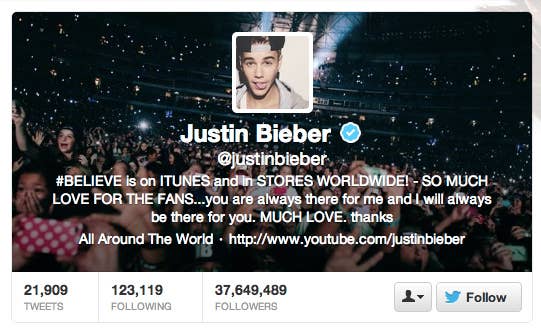
In the early days, Facebook and Twitter felt a bit like games. Search and find old friends! Follow people indiscriminately with the hope of guilting strangers into following you! Use hashtags, jump on worldwide trends, and, above all, watch your followers grow.
Today, though, a lot has changed. Our accounts have become more real — extensions of our actual lives, and places where important conversations actually take place. While the thrill of receiving new followers hasn't completely gone away, our fixation on a precise number seems to have dwindled. We've become more focused on what internet companies call engagement. And those companies have started to notice.
Take Tumblr. The site doesn't show a follower metric publically — a calculated move by the company, which told a small audience last month at South By Southwest that taking the focus off the numbers allows users to focus on creating things rather than obsessing on stats. Instagram straddles the line, providing public follower numbers, but providing little emphasis on the number. Unlike Twitter, which emails you when you get new followers, Instagram's new-follow alterts are relegated to your phone's notification tray.
Facebook has recently struggled with follower-style system, which was introduced in the form of a "subscriber" button in September 2011. As the New York Times pointed out in March, subscriber numbers for prominent profiles ballooned after enabling the feature, but yielded little in the way of actual engagement and sharing. Bilton's article prompted a defensive response from Facebook, but the takeaway was clear: your follow count on Facebook barely matters.
Twitter, too, has publicly grappled with the significance of the follower count. The fake follower business is evidently booming, with dummy accounts becoming more sophisticated and tougher to differentiate from real accounts. It's possible to have a million followers, and yet no followers at all.

Suhail Doshi, founder of Mixpanel, a mobile analytics company, sees advertisers demanding more than raw follower counts. "If I'm a brand and I'm putting in millions of dollars and my social media accounts are getting followers, that's great. But I don't know if I'm getting a return on that," he told BuzzFeed. "The [follower] metric will become obsolete, just like page views."
Similarly to page views, which were once the gold standard for measuring success online but supplanted in part by unique visitors, the notion of the follower says very little about how people are actually interacting with Tweets and links shared online. Twitter is keenly aware of this and, as co-founder Ev Williams hinted last year at an event at BuzzFeed, the company seems to be looking at better ways to express things like influence and interest. "The dream metric is how many people saw your tweet," he told the crowd. When asked, Twitter declined to comment for this post.
The growing irrelevance of the follower count leaves an opening for services like Klout, which, while often the butt of jokes, looks an awful lot like a theoretical Twitter "engagement" score. Twitter currently provides tools for advertisers to show how widely tweeted links are actually shared. They're limited, and not available to regular users, but that dramatically change how you feel about your Twitter account — they show actual impact, not projected impact. For a person, it can be humbling. For a business, though, it's vital information. And with Facebook and Twitter pushing harder than ever to court advertisers, companies with money to spend will most likely get what they want.
That said, the follower probably won't go away completely or without a fight. "I don't think Twitter will ever totally remove follower counts, but I think they'll do away with them as a key metric," Doshi said. "I can't imagine [Twitter] killing it off altogether though. People just like to know where they stand."
